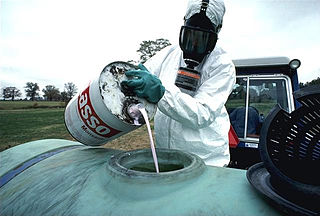
Genetically modified maize (corn) is a genetically modified crop. Specific maize strains have been genetically engineered to express agriculturally-desirable traits, including resistance to pests and to herbicides. Maize strains with both traits are now in use in multiple countries. GM maize has also caused controversy with respect to possible health effects, impact on other insects and impact on other plants via gene flow. One strain, called Starlink, was approved only for animal feed in the US but was found in food, leading to a series of recalls starting in 2000.

Pesticides are substances that are meant to control pests. The term pesticide includes all of the following: herbicide, insecticides nematicide, molluscicide, piscicide, avicide, rodenticide, bactericide, insect repellent, animal repellent, antimicrobial, fungicide, and lampricide. The most common of these are herbicides which account for approximately 80% of all pesticide use. Most pesticides are intended to serve as plant protection products, which in general, protect plants from weeds, fungi, or insects. As an example, the fungus Alternaria solani is used to combat the aquatic weed Salvinia.

Daminozide – also known as Alar, Kylar, B-NINE, DMASA, SADH, or B 995 – is a plant growth regulator, a chemical sprayed on fruit to regulate growth, make harvest easier, and keep apples from falling off the trees before they ripen so they are red and firm for storage. Alar was first approved for use in the U.S. in 1963. It was primarily used on apples until 1989, when the manufacturer voluntarily withdrew it after the U.S. Environmental Protection Agency proposed banning it based on concerns about cancer risks to consumers.

The U.S. National Ambient Air Quality Standards are limits on atmospheric concentration of six pollutants that cause smog, acid rain, and other health hazards. Established by the United States Environmental Protection Agency (EPA) under authority of the Clean Air Act, NAAQS is applied for outdoor air throughout the country.

The Federal Insecticide, Fungicide, and Rodenticide Act (FIFRA) is a United States federal law that set up the basic U.S. system of pesticide regulation to protect applicators, consumers, and the environment. It is administered and regulated by the United States Environmental Protection Agency (EPA) and the appropriate environmental agencies of the respective states. FIFRA has undergone several important amendments since its inception. A significant revision in 1972 by the Federal Environmental Pesticide Control Act (FEPCA) and several others have expanded EPA's present authority to oversee the sales and use of pesticides with emphasis on the preservation of human health and protection of the environment by "(1) strengthening the registration process by shifting the burden of proof to the chemical manufacturer, (2) enforcing compliance against banned and unregistered products, and (3) promulgating the regulatory framework missing from the original law".

Atrazine is a herbicide of the triazine class. It is used to prevent pre-emergence broadleaf weeds in crops such as maize (corn) and sugarcane and on turf, such as golf courses and residential lawns. Atrazine's primary manufacturer is Syngenta and it is one of the most widely used herbicides in the United States and Australian agriculture.
The Advancement of Sound Science Center (TASSC), formerly The Advancement of Sound Science Coalition, was an industry-funded lobby group and crisis management vehicle, and was created in 1993 by Phillip Morris and APCO in response to a 1992 United States Environmental Protection Agency (EPA) report which identified secondhand smoke as a "confirmed" human carcinogen. TASSC's stated objectives were to: (1) discredit the EPA report; (2) fight anti-smoking legislation; and (3) pro-actively pass legislation favourable to the tobacco industry.
The Climate Change Science Program (CCSP) was the program responsible for coordinating and integrating research on global warming by U.S. government agencies from February 2002 to June 2009. Toward the end of that period, CCSP issued 21 separate climate assessment reports that addressed climate observations, changes in the atmosphere, expected climate change, impacts and adaptation, and risk management issues. Shortly after President Obama took office, the program's name was changed to U.S. Global Change Research Program (USGCRP) which was also the program's name before 2002. Nevertheless, the Obama Administration generally embraced the CCSP products as sound science providing a basis for climate policy. Because those reports were mostly issued after the Fourth Assessment Report of the Intergovernmental Panel on Climate Change (IPCC), and in some cases focused specifically on the United States, they were generally viewed within the United States as having an importance and scientific credibility comparable to the IPCC assessments for the first few years of the Obama Administration.

The Food Quality Protection Act (FQPA), or H.R.1627, was passed unanimously by Congress in 1996 and was signed into law by President Bill Clinton on August 3, 1996. The FQPA standardized the way the Environmental Protection Agency (EPA) would manage the use of pesticides and amended the Federal Insecticide, Fungicide, and Rodenticide Act and the Federal Food Drug and Cosmetic Act. It mandated a health-based standard for pesticides used in foods, provided special protections for babies and infants, streamlined the approval of safe pesticides, established incentives for the creation of safer pesticides, and required that pesticide registrations remain current.
The Pest Management Regulatory Agency (PMRA) is the Canadian government agency responsible for the regulation of pest control products in Canada under the federal authority of the Pest Control Products Act and Regulations. The agency is a branch that reports to Parliament through Health Canada. The PMRA is responsible for providing access to pest management tools while minimizing the risks to human health and the environment by “using modern evidence-based scientific approaches to pesticide regulation, in an open and transparent manner”. Their main activity areas include: new product evaluation, post market review and compliance and enforcement.

Clothianidin is an insecticide developed by Takeda Chemical Industries and Bayer AG. Similar to thiamethoxam and imidacloprid, it is a neonicotinoid. Neonicotinoids are a class of insecticides that are chemically similar to nicotine, which has been used as a pesticide since the late 1700s. Clothianidin and other neonicotinoids act on the central nervous system of insects as an agonist of acetylcholine, the neurotransmitter that stimulates nAChR, targeting the same receptor site (AChR) and activating post-synaptic acetylcholine receptors but not inhibiting AChE. Clothianidin and other neonicotinoids were developed to last longer than nicotine, which is more toxic and which breaks down too quickly in the environment. However, studies published in 2012 show that neonicotinoid dust released at planting time may persist in nearby fields for several years and be taken up into non-target plants, which are then foraged by bees and other insects.

Tyrone B. Hayes is an American biologist and professor of Integrative Biology at University of California, Berkeley known for his research concluding that the herbicide atrazine is an endocrine disruptor that demasculinizes and feminizes male frogs. He is also an advocate for critical review and regulation of pesticides and other chemicals that may cause adverse health effects. He has presented hundreds of papers, talks, and seminars on his conclusions that environmental chemical contaminants have played a role in global amphibian declines and in the health disparities that occur in minority and low income populations.

The Office of Environmental Health Hazard Assessment, commonly referred to as OEHHA, is a specialized department within the cabinet-level California Environmental Protection Agency (CalEPA) with responsibility for evaluating health risks from environmental chemical contaminants.
The United States is the largest grower of commercial crops that have been genetically engineered in the world, but not without domestic and international opposition.
The Science Advisory Board (SAB) is a United States group of independent scientists selected by the Administrator of the U.S. Environmental Protection Agency (EPA). The board provides advice to the agency on the scientific and technical aspects of environmental problems and issues. Upon a request by the Administrator, the board reviews the scientific aspects of any reports or other written products prepared by the agency. Congress established the board in the Environmental Research, Development, and Demonstration Authorization Act of 1978.

The California Department of Pesticide Regulation, also known as DPR or CDPR, is one of six boards and departments of the California Environmental Protection Agency (Cal/EPA).
Regulatory science is the scientific and technical foundations upon which regulations are based in various industries – particularly those involving health or safety. Regulatory bodies employing such principles in the United States include, for example, the FDA for food and medical products, the EPA for the environment, and the OSHA for work safety.

Pesticide regulation in the United States is primarily a responsibility of the Environmental Protection Agency. In America, it was not till the 1950s that pesticides were regulated in terms of their safety. The Pesticides Control Amendment (PCA) of 1954 was the first time Congress passed guidance regarding the establishment of safe limits for pesticide residues on food. It authorized the FDA to ban pesticides they determined to be unsafe if they were sprayed directly on food. The Food Additives Amendment, which included the Delaney Clause, prohibited the pesticide residues from any carcinogenic pesticides in processed food. In 1959, pesticides were required to be registered.
The NSW Environment Protection Authority (EPA) is an independent statutory authority that sits in the Environment portfolio as part of the Planning, Industry and Environment cluster. The NSW EPA was established as an independent governing Board in February 2012 separate from the Office of Environment and Heritage. The NSW EPA is the State’s primary environmental regulator, working with businesses, government, community and environment groups to manage and reduce pollution, waste and adverse impacts on the environment.
Genetic engineering in North America is any genetic engineering activities in North America










